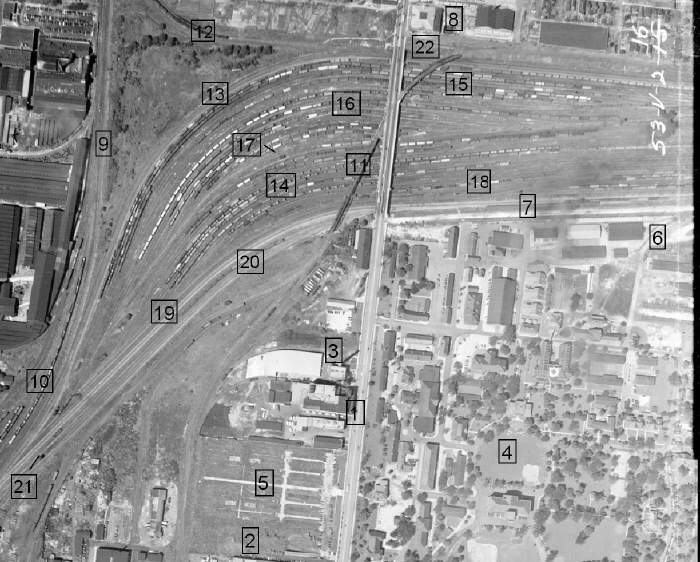|
Photo of the Month - October 2008 Cleveland Avenue Area - Aerial View
Expand with numbers - Expand without numbers
In the 1950's Cleveland Avenue connected East Broad Street with the west side of Westerville. It was part of the route of the Columbus-Westerville interurban line, the Cleveland Avenue streetcar line and in 1934 the first trolley coach line in Columbus. Driving north on Cleveland Avenue from East Broad Street, before coming to the railroad tracks, you couldn't help but smell bread baking at the large Kroger bakery (key #2). Even if that white bread wasn't good for you it sure smelled good. After the bakery, on the right, was Ft Hayes (key #4), a very busy place during World War II. During the war additional barracks were build on the west side of Cleveland Avenue (key #5). One long time Columbus resident, who's mother was the secretary to the post commander during the war, remembers cars had to stop while solders were marched across Cleveland Avenue to the main Fort. On the north side of Ft Hayes was a loading platform (key #7) used during WW II for troop trains. Sometimes they would be picking up or delivering solders, other times troop trains would stop while the solders were fed at the post mess hall. They would then march back to their train and continue on their journey. Even in 1958 when central Ohio residents joined or were drafted into the army they were mustered in at Ft. Hayes (me!). As you drove further north over the railroad tracks to the middle of the Cleveland Avenue bridge you came upon a grade crossing. The N&W, also on a bridge, crossed the Cleveland Avenue bridge at grade. The N&W bridge was actually three bridges, two of girder construction connected by the middle bridge, a concrete structure. The two girder bridges were build first. When built they were connected by land. When the Pennsy expanded their yard, adding tracks between the West Classification yard (key #14) and the CA&C yard (key #15), that spit of land was reshaped requiring the middle bridge to connect the two girder bridges making a grade crossing on a bridge. One map labels this new section as the Milo Yard (key #16). The N&W track (key #13) led to the two N&W freight houses on Mt. Vernon Avenue. The three bridges, mentioned above, had a weight restriction and the N&W allowed only their Class M, 4-8-0, to use the bridge. Those twelve wheelers were very popular with the railfans. When the N&W dieselized they no longer used separate switchers at the Joyce Avenue Yard. Instead they would use a GP-9 from one of their freight trains for a switch engine. They did have one special switcher just for the freight house track. The story goes that one day someone inadvertently took a GP 9 over the bridges and there after they started using the GP 9's on the freight house run as well. Driving further north on Cleveland Avenue you came to the Cleveland Avenue trolley coach barn on the right (key #8). This facility was also know as the Milo car house. When the facility was built in 1894, for the Columbus Central Railway Co., it included a power house for the Columbus-Westerville line as well as a car house. It was purchased by the Columbus Railway Power & Light Co. and by 1953 was used as a trolley coach barn. As you look over the photo notice that four of the five Columbus railroads had trackage through the Cleveland Avenue area. Only the C&O RR is missing. Also look for the very smoky steam locomotive to the right of the white number "53". The smoke is drifting over Ft. Hayes as it always did. |
||||||||||||||||||||||||||||||||||||||||||||
